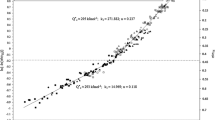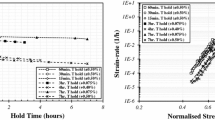Abstract
Operating structural components experience complex loading conditions resulting in 3D stress states. Current design practice estimates multiaxial creep rupture life by mapping a general state of stress to a uniaxial creep rupture correlation using effective stress measures. The data supporting the development of effective stress measures are nearly always only uniaxial and biaxial, as 3D creep rupture tests are not widely available. This limitation means current effective stress measures must extrapolate from 2D to 3D stress states, potentially introducing extrapolation error. In this work, we use a physics-based, crystal plasticity finite element model to simulate uniaxial, biaxial, and triaxial creep rupture. We use the virtual dataset to assess the accuracy of current and novel effective stress measures in extrapolating from 2D to 3D stresses and also explore how the predictive accuracy of the effective stress measures might change if experimental 3D rupture data was available. We confirm these conclusions, based on simulation data, against multiaxial creep rupture experimental data for several materials, drawn from the literature. The results of the virtual experiments show that calibrating effective stress measures using triaxial test data would significantly improve accuracy and that some effective stress measures are more accurate than others, particularly for highly triaxial stress states. Results obtained using experimental data confirm the numerical findings and suggest that a unified effective stress measure should include an explicit dependence on the first stress invariant, the maximum tensile principal stress, and the von Mises stress.








Similar content being viewed by others
Notes
Henceforth, we refer to a triaxial stress state as any stress tensor with all three principal values with non-negligible magnitudes.
References
Katz A, Ranjan D (2019) Advances towards elastic-perfectly plastic simulation of the core of printed circuit heat exchangers. In: Proceedings of the 2019 ASME pressure vessels and piping conference, vol 58943, American Society of Mechanical Engineers, pp PVP2019-93807
Rovinelli A, Messner MC, Guosheng Y, Sham TL (2019) Initial study of notch sensitivity of Grade 91 using mechanisms motivated crystal plasticity finite element method. Tech. Rep., Argonne National Laboratory ANL-ART-171
Hayhurst D (1973) A biaxial-tension creep-rupture testing machine. J Strain Anal 8(2):119–123
Dyson BF, Mclean D (1977) Creep of nimonic 80A in torsion and tension. Metal Sci 11(2):37–45. https://doi.org/10.1179/msc.1977.11.2.37
Stanzl S, Argon A, Tschegg E (1983) Diffusive intergranular cavity growth in creep in tension and torsion. Acta Metall 31(6):833–843
Kennedy C, Harms W, Douglas D (1959) Multiaxial creep studies on inconel at 1500 F. J Basic Eng 81(4):599–607
Chubb EJ, Bolton CJ (1980) Stress state dependence of creep deformation and fracture in AISI type 316 stainless steel. Mechanical Engineering Publications Limited, United Kingdom
Hayhurst D, Felce I (1986) Creep rupture under tri-axial tension. Eng Fract Mech 25(5):645–664. https://doi.org/10.1016/0013-7944(86)90030-5
Sakane M, Hosokawa T (2001) Biaxial and triaxial creep testing of type 304 stainless steel at 923 k. In: IUTAM symposium on creep in structures, Springer, pp 411–418
Larson FR, Miller J (1952) A time-temperature relationship for rupture and creep stresses. Trans ASME 74:765–775
Tresca HE (1864) Sur l’ecoulement des corps solides soumis a de fortes pressions, Imprimerie de Gauthier-Villars successeur de Mallet-Bachelier, rue de Seine
Mises RV (1913) Mechanik der festen körper im plastisch-deformablen zustand. Nachrichten von der Gesellschaft der Wissenschaften zu Göttingen, Mathematisch-Physikalische Klasse, pp 582–592
Hayhurst D (1972) Creep rupture under multi-axial states of stress. J Mech Phys Solids 20(6):381–382. https://doi.org/10.1016/0022-5096(72)90015-4
Leckie F, Hayhurst D (1974) Creep rupture of structures. Proc R Soc Lond A Math Phys Sci 340(1622):323–347
Leckie F, Hayhurst D (1977) Constitutive equations for creep rupture. Acta Metall 25(9):1059–1070
Hayhurst DR, Leckie FA, Morrison CJ (1978) Creep rupture of notched bars. Proc R Soc A Math Phys Eng Sci 360(1701):243–264. https://doi.org/10.1098/rspa.1978.0066
Huddleston R (1985) An improved multiaxial creep-rupture strength criterion. J Press Vessel Technol 107(4):421–429
Huddleston R (1993) Assessment of an improved multiaxial strength theory based on creep-rupture data for type 316 stainless steel. J Press Vessel Technol 115(2):177–184
Huddleston R (1993) Assessment of an improved multiaxial strength theory based on creep-rupture data for Inconel 600. Tech. Rep., Oak Ridge National Laboratory (ORNL), Oak Ridge, TN. https://doi.org/10.2172/10168640
American Society of Mechanical Engineers (2019) ASME Boiler and Pressure Vessel Code Section III, Division 5. American Society of Mechanical Engineers
American Society of Mechanical Engineers and American Petroleum Institute (2016) Fitness-For-Service, API 579–1/ASME FFS-1. American Society of Mechanical Engineers and American Petroleum Institute
EDF Energy Nuclear Generation Ltd (2012) Assessment Procedure for the High Temperature Response of Structures, R5. British. Energy
AFCEN (2015) RCC-MRx, AFCEN
Nassif O, Truster TJ, Ma R, Cochran KB, Parks DM, Messner MC, Sham T-L (2019) Combined crystal plasticity and grain boundary modeling of creep in ferritic-martensitic steels: I. Theory and implementation. Modell Simul Mater Sci Eng 27(7):075009. https://doi.org/10.1088/1361-651X/ab359c
Kloc L, Sklenička V (1997) Transition from power-law to viscous creep behaviour of p-91 type heat-resistant steel. Mater Sci Eng A 234:962–965
Haney EM, Dalle F, Sauzay M, Vincent L, Tournié I, Allais L, Fournier B (2009) Macroscopic results of long-term creep on a modified 9Cr–1Mo steel. Mater Sci Eng A 510:99–103
Sham T-L, Needleman A (1983) Effects of triaxial stressing on creep cavitation of grain boundaries. Acta Metall 31(6):919–926. https://doi.org/10.1016/0001-6160(83)90120-7
Needleman A, Rice JR (1980) Plastic creep flow effects in the diffusive cavitation of grain boundaries. Acta Metall 28(10):1315–1332. https://doi.org/10.1016/0001-6160(80)90001-2
Van Der Giessen E, der Burg MWD, Needleman A, Tvergaard V (1995) Void growth due to creep and grain boundary diffusion at high triaxialities. J Mech Phys Solids 43(1):123–165. https://doi.org/10.1016/0022-5096(94)00059-E
Van Der Giessen E, Tvergaard V (1996) Micromechanics of intergranular creep failure under cyclic loading. Acta Mater 44(7):2697–2710
Onck P, Van Der Giessen E (1998) Growth of an initially sharp crack by grain boundary cavitation. J Mech Phys Solids 47(1):99–139. https://doi.org/10.1016/S0022-5096(98)00078-7
Raj R, Ashby M (1971) On grain boundary sliding and diffusional creep. Metall Trans 2(4):1113–1127
Ashby M (1972) Boundary defects, and atomistic aspects of boundary sliding and diffusional creep. Surf Sci 31:498–542
Crossman F, Ashby M (1975) The non-uniform flow of polycrystals by grain-boundary sliding accommodated by power-law creep. Acta Metall 23(4):425–440
Quey R, Dawson P, Barbe F (2011) Large-scale 3d random polycrystals for the finite element method: generation, meshing and remeshing. Comput Methods Appl Mech Eng 200(17–20):1729–1745
Manjoine MJ (1975) Ductility indices at elevated temperature. J Eng Mater Technol 97(2):156–161. https://doi.org/10.1115/1.3443276
Cocks A, Ashby M (1982) On creep fracture by void growth. Prog Mater Sci 27(3–4):189–244
Spindler M (2007) An improved method for calculation of creep damage during creep–fatigue cycling. Mater Sci Technol 23(12):1461–1470
Yatomi M, Nikbin K (2014) Numerical prediction of creep crack growth in different geometries using simplified multiaxial void growth model. Mater High Temp 31(2):141–147
le Graverend J-B, Adrien J, Cormier J (2017) Ex-situ X-ray tomography characterization of porosity during high-temperature creep in a Ni-based single-crystal superalloy: toward understanding what is damage. Mater Sci Eng A 695:367–378
Andrea R (2021) Data for article accurate effective stress measures: predicting creep life for 3d stresses using 2d and 1d creep rupture simulations and data. https://doi.org/10.17632/kcbcnywygr.1, Mendeley Data, V1
Kimura K, Kushima H, Sawada K (2009) Long-term creep deformation property of modified 9Cr–1Mo steel. Mater Sci Eng A 510–511(C):58–63. https://doi.org/10.1016/j.msea.2008.04.095
Kimura K, Sawada K, Kushima H (2010) Creep rupture ductility of creep strength enhanced ferritic steels, American Society of Mechanical Engineers. Press Vessels Pip Div 6:837–846. https://doi.org/10.1115/PVP2010-25297
Jones E, Oliphant T, Peterson P et al (2001) SciPy: open source scientific tools for Python. http://www.scipy.org/
Byrd RH, Gilbert JC, Nocedal J (2000) A trust region method based on interior point techniques for nonlinear programming. Math Program 89(1):149–185
Abe F (2016) Heat-to-heat variation in creep life and fundamental creep rupture strength of 18Cr–8Ni, 18Cr–12Ni–mo, 18Cr–10Ni–Ti, and 18Cr–12Ni–Nb stainless steels. Metall Mater Trans A 47(9):4437–4454
Henry BS, Luxmoore AR (1997) The stress triaxiality constraint and the Q-value as a ductile fracture parameter. Eng Fract Mech 57(4):375–390. https://doi.org/10.1016/s0013-7944(97)00031-3
Messner MC, Nassif O, Ma R, Truster TJ, Cochran K, Parks D, Sham T-L (2019) Combined crystal plasticity and grain boundary modeling of creep in ferritic-martensitic steels: II. The effect of stress and temperature on engineering and microstructural properties. Modell Simul Mater Sci Eng 27(7):075010. https://doi.org/10.1088/1361-651X/ab359f
Nicolas A, Messner MC, Sham T-L (2021) A method for predicting failure statistics for steady state elevated temperature structural components. Int J Press Vessels Pip 192:104363
Acknowledgements
The research was sponsored by the US Department of Energy, under Contract No. DEAC02-06CH11357 with Argonne National Laboratory, managed and operated by UChicago Argonne LLC and Contract No. DE-AC07-05ID14517 with Idaho National Laboratory, managed and operated by Battelle Energy Alliance. Programmatic direction was provided by the Office of Nuclear Reactor Deployment of the Office of Nuclear Energy. The authors gratefully acknowledge the support provided by Sue Lesica, Federal Manager, Advanced Materials, Advanced Reactor Technologies (ART) Program, Diana Li, Federal Manager, Microreactor Program, and John H. Jackson of Idaho National Laboratory, National Technical Director, Microreactor Program.
Author information
Authors and Affiliations
Corresponding author
Ethics declarations
Conflict of interest
The authors declare no competing interests.
Rights and permissions
About this article
Cite this article
Rovinelli, A., Messner, M.C., Parks, D.M. et al. Accurate Effective Stress Measures: Predicting Creep Life for 3D Stresses Using 2D and 1D Creep Rupture Simulations and Data. Integr Mater Manuf Innov 10, 627–643 (2021). https://doi.org/10.1007/s40192-021-00228-1
Received:
Accepted:
Published:
Issue Date:
DOI: https://doi.org/10.1007/s40192-021-00228-1




